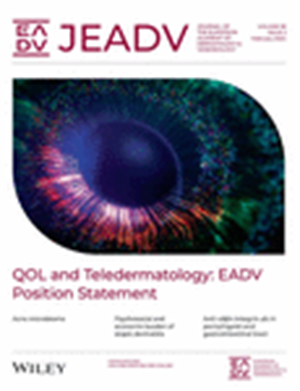Efficacy and safety of etrasimod in alopecia areata: A multicentre, randomized, double-blind, placebo-controlled, Phase 2 study
Abstract
Background
Etrasimod, an oral, selective sphingosine 1-phosphate 1, 4 and 5 receptor modulator approved for the treatment of ulcerative colitis, has been studied in immune-mediated inflammatory diseases, including alopecia areata (AA).
Objectives
To evaluate the efficacy and safety of etrasimod in adults with moderate to severe AA.
Methods
This Phase 2, randomized, double-blind, placebo-controlled trial included patients (aged ≥18 years) with moderate to severe AA, defined as a Severity of Alopecia Tool (SALT) score of ≥25. Patients were sequentially enrolled into two cohorts. Cohort 1 included patients (SALT score of ≥50) randomized 2:1 to etrasimod 2 mg or placebo. Cohort 2 included patients (SALT score ≥25 to <95) randomized 4:1:2 to etrasimod 3 mg, 2 mg or placebo. Patients completed a 24-week double-blind and 28-week open-label extension period. The primary endpoint was percent change from baseline (%CFB) in SALT score at Week 24. Safety was monitored throughout the trial.
Results
Eighty patients were randomized to etrasimod 2 mg (n = 31), 3 mg (n = 25) or placebo (n = 24). At Week 24, least squares mean (SE) percent changes from baseline in SALT score for the etrasimod 2 mg, 3 mg and placebo groups were −13.8 (8.6), −21.4 (6.9) and 0.35 (8.9), respectively. The least squares mean difference (95% CI; P value) in SALT score %CFB of etrasimod 2 mg and 3 mg versus placebo was −14.1 (−38.9 to 10.6; p = 0.2579) and − 21.8 (−44.4 to 0.9; p = 0.0592), respectively; statistical superiority was not achieved. The proportions of patients achieving ≥30%, ≥50% or ≥75% improvement in baseline SALT score at Week 24 were generally numerically higher in etrasimod groups versus placebo. Treatment-emergent adverse events occurred in 67.7%, 80.0% and 78.3% of patients receiving etrasimod 2 mg, 3 mg and placebo, respectively, by Week 24.
Conclusions
Etrasimod did not meet the primary and secondary efficacy endpoints, but efficacy was numerically higher with etrasimod than with placebo. The etrasimod clinical programme for AA has been discontinued. Etrasimod was well tolerated, and its safety profile was consistent with other etrasimod studies to date.
Trial Registration
ClinicalTrials.gov: NCT04556734.


 求助内容:
求助内容: 应助结果提醒方式:
应助结果提醒方式:


